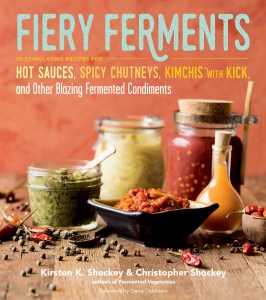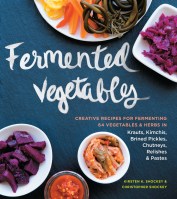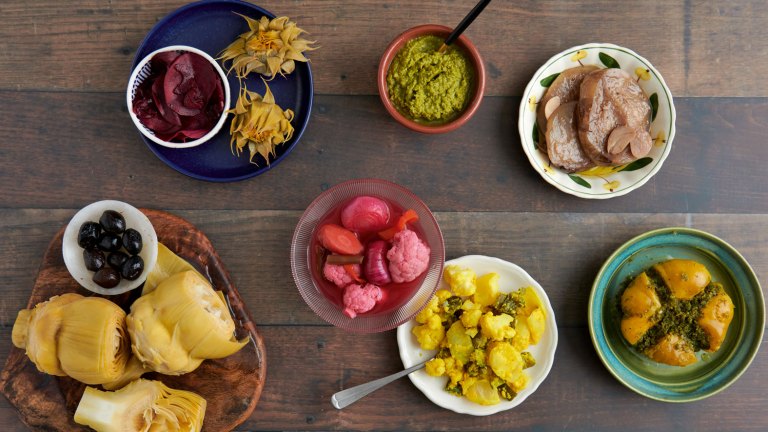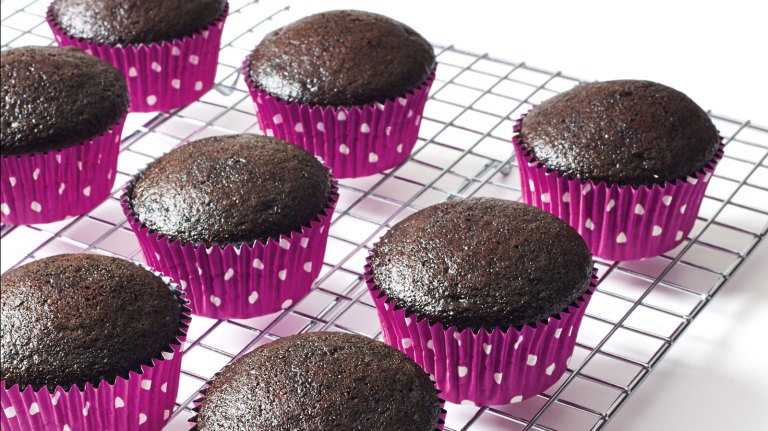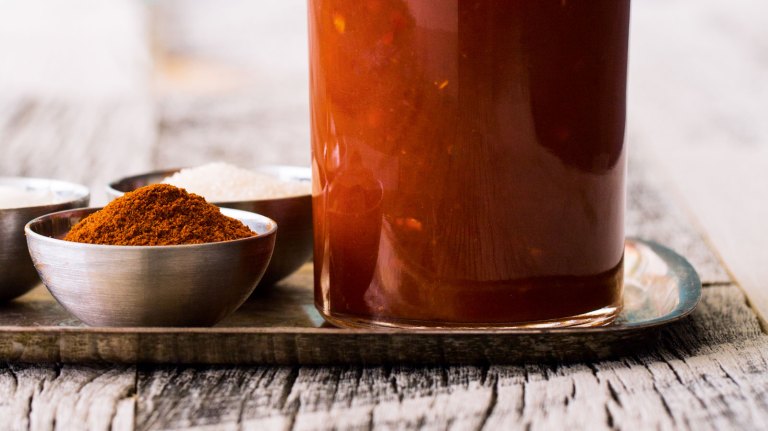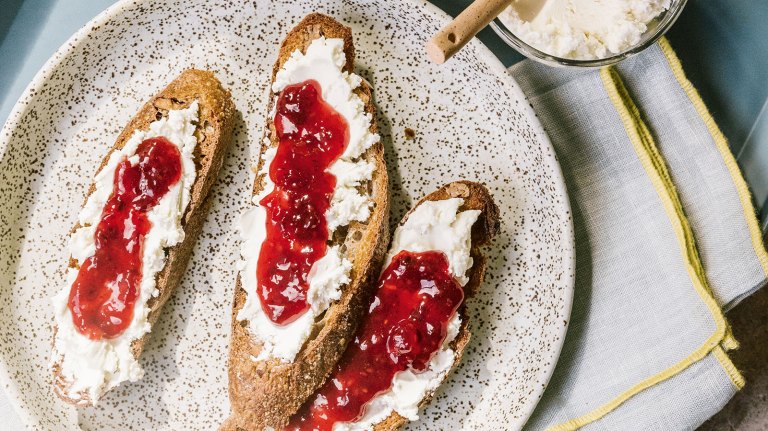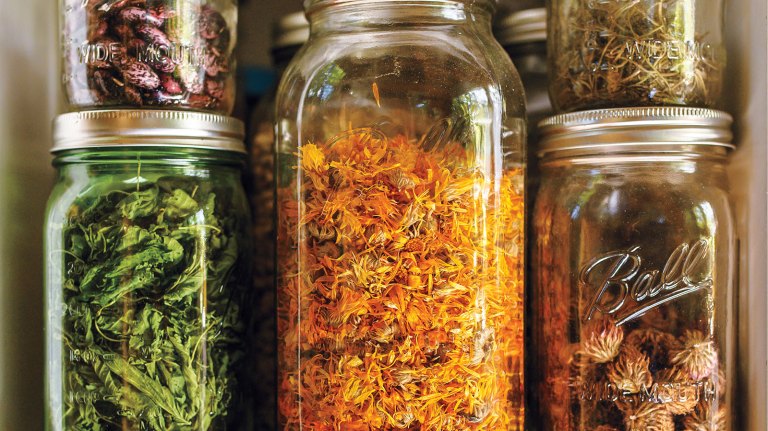Fermented Cranberries, Two Ways
Swap your standard cranberry sauce for fermented cranberry condiments that will please your palate and your gut.
It probably won’t surprise you to learn that, in our house, fermented vegetables are an important part of our holiday meals.
I could say ferments play a prominent role because I take great pride in putting out food we grew and preserved at the peak of flavor. I could say it’s because these flavorful foods add pizazz and complexity to our plates. All of this is true. But the real story is that the heavy emphasis on eating that comes with celebration makes all of us prone to overindulgence — and ferments are great for that, too.
Not only do fermented foods preserve and enhance B and C vitamins (good for keeping blood sugar levels in check and for the immune system), but they’re alive with digestive enzymes and probiotics that aid in digestion. In other words, ferments help us enjoy our meals not only as we eat, but in the hours after, too, as they make it easier for our bodies to process all that extra deliciousness we couldn’t resist.
Some of our personal favorite ferments for this time of year are Fermented Carrot Sticks, Edgy Veggies, Pickled Brussel Sprouts, and Dilly Beans (all recipes found in our book Fermented Vegetables), because we can put out pickle-y, probiotic version of a vegetable platter for our guests.
If sour ferments aren’t your thing, or if your guests are wary of fermented foods, another simple way to incorporate ferments into your holiday meal is to simply replace standard cranberry sauce with fermented Cranberry Relish. It’s so tasty, no one will know it’s fermented unless you tell them.
And — if you want to go all out — make Chocolate-Cranberry Mole from our book Fiery Ferments and serve it over vanilla ice cream for dessert. Happy eating!
Cranberry Relish
Yield: about 1 quart
(Fermentation vessel: 2 quarts)
This is a simple conversion of traditional cooked cranberries with oranges to a fermented relish. Adding juice-sweetened dried cranberries balances the tartness of fresh ones. If it’s not sweet enough for your taste, simply splash in a bit of maple syrup or honey before serving.
Note: Although it’s always better to use fresh ingredients, you can make this relish with frozen cranberries. It’ll have a softer consistency but is otherwise just as scrumptious.
Ingredients
- 2 oranges
- 2 (8-ounce) packages fresh cranberries
- ½ teaspoon unrefined sea salt
- 1 cup fruit juice-sweetened dried cranberries
- 1 tablespoon chopped candied ginger (optional)
Directions
Wash the oranges, and zest one of them. Peel and section both oranges, then remove the membranes from the sections (the chewy, sometimes bitter membranes can negatively affect the texture of the ferment). Chop the sections and set aside.
Wash the fresh cranberries and put them in a food processor; pulse until lightly chopped. Transfer to a bowl and massage in the salt for a minute to develop the brine. Then mix in the dried cranberries, the orange zest and sections, and the ginger, if using.
Press the mixture into a jar or crock, making sure there are no air pockets. The brine will be a little thick from the oranges. Top the ferment with a quart-sized ziplock bag. Press the plastic down onto the top of the ferment, then fill it with water and seal; this will act as both follower and weight.
Set aside on a baking sheet to ferment, somewhere nearby, out of direct sunlight, and cool, for 5 to 7 days. Check daily to make sure the fruits are submerged, pressing down as needed to bring the brine to the surface. You may see scum on top; it’s generally harmless, but consult the appendix in Fermented Vegetables if you’re at all concerned.
Test the ferment on day 5. It will be the same deep crimson color of cooked relish and will have two sour notes: one from the cranberries and one from fermentation.
Store in jars, with lids tightened, in the fridge, leaving as little headroom as possible, and tamping the relish down under the brine. This ferment will keep, refrigerated, for 6 months.
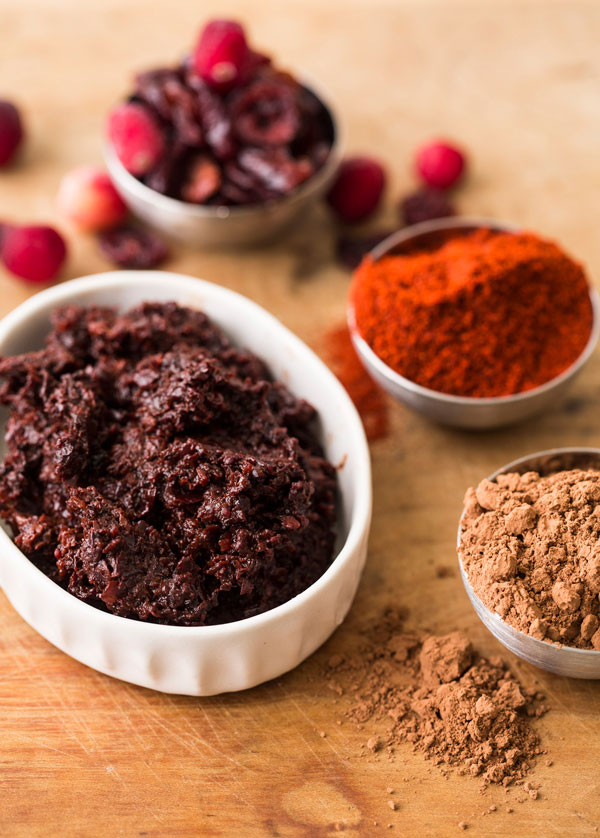
Chocolate-Cranberry Mole
Yield: About 1½ pints
Heat index: 2
A new favorite! Straight out of the jar? Yes, please! On a sandwich?! In a wrap? On a dessert? In a plane? On a train? Absolutely. If you don’t have dried unsweetened cherries, you can substitute an equal amount of additional dried cranberries.
Ingredients
- 4 cups (1 pound) fresh cranberries
- 1 cup dried cranberries
- ½ cup dried unsweetened cherries
- 5 tablespoons (2 ounces) pasilla chile powder
- ¼ teaspoons cocoa powder
- ½ cup fresh orange juice
- ¾ teaspoon salt
Directions
Combine the fresh cranberries, dried cranberries, cherries, chile powder, and cocoa powder in a food processor. Add the orange juice and process the mixture to a paste consistency. Sprinkle in the salt.
Pack the paste into a jar that is just the right size for your ferment, pressing out any air pockets as you go. Leave about 1 inch of headspace.
Press a piece of plastic (or other cartouche) against the surface of the ferment, being careful not to trap any air beneath it. Screw the lid down tightly.
Set the jar in a corner of the kitchen to ferment, and watch for air pockets forming in the paste. If you see any, open the lid and press the paste back down. If the lid starts to bulge, simply open it for a moment to “burp” the ferment.
Allow to ferment for 7 to 14 days. You will know it is ready when the cranberries have a delightful lemony flavor and all the flavors have mingled together.
When it is ready, place a clean small round of plastic or parchment paper directly on top of the paste. Tighten the lid, then store in the fridge, where this ferment will keep for up to 12 months.
CRANBERRY RELISH RECIPE EXCERPTED FROM FERMENTED VEGETABLES © KIRSTEN K. SHOCKEY AND CHRISTOPHER SHOCKEY. CHOCOLATE-CRANBERRY MOLE RECIPE EXCERPTED FROM FIERY FERMENTS © KIRSTEN K. SHOCKEY AND CHRISTOPHER SHOCKEY. CHOCOLATE-CRANBERRY MOLE PHOTO © LARA FERRONI.
